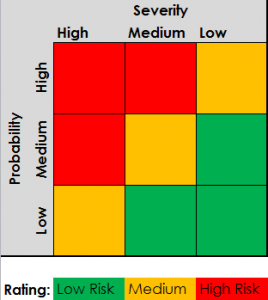Risk management is an essential component of running any successful business. For many professionals employed in large organisations, risk management tasks often comprise bulk of their working week. This could be driven by the legislative requirements, type of industry business operates or a component of managerial control in the organisation. In any case, risk management is required to improve business and manage hazards effectively. In small and medium enterprises (SMEs) we often see that risk management takes a back seat. This is often caused by lack of resources, close understanding of business by its owners/managers and lack of knowledge of risk management techniques. However, legislative requirements and hazards apply to small businesses as much as they do in the large businesses. Probably the best examples of risk management come from the requirements listed Occupational Health & Safety laws. Same principles can be applied to other areas of business, for example environmental compliance, service quality and data security. Risk management process can be divided in few simple steps:
- Hazard identification
- Risk assessment
- Risk control plans
Hazard Identification
A hazard is a situation that poses some level of threat to safety, security, environment, etc. When combined with vulnerability, hazard becomes a risk. In safety sense, a computer cable on the floor can pose a tripping hazard. The potential risk of someone tripping over that cable is in falling and causing personal injury. In a business situation hazard can be a dormant treat to the organisation, for example a weak antivirus internet protection. If the organisation relies on internet for its daily operations, a lack of sound antivirus protection might result in a risk of PC infection and inability to carry out business. Identifying hazards and associated risks is a basis for sound risk management. The key to good hazard identification is in involving affected employees in the process, listening and observing the concerns.
Risk Assessment
Once hazards are identified, risk is assessed using a measure of the Severity of consequence of the risk situation and the Probability that the risk situation might eventuate. A combination of Severity and Probability will result in the assessed level of risk. This process sometimes can be subjective, so the involvement of a skilled casino polska risk assessment facilitator and employees with sound process knowledge is essential.  Level of risk needs to be assessed assuming no controls are in place and reassessed with current controls in mind. This makes it possible to assess whether further risk controls are required.
Level of risk needs to be assessed assuming no controls are in place and reassessed with current controls in mind. This makes it possible to assess whether further risk controls are required.
Risk Controls
Depending on the level of risk, business would be required to plan actions aimed to control identified risks (risk controls). For example very low level of risk might already have a sufficient level of control and any additional controls would be wasteful. However, if the risk was assessed as ‘High’, and current controls are not deemed to be adequate, additional controls might need to be planned with some level of urgency. This will then provide the actions items in the business risk management plan. In the end, risk controls will always depend on the business model, legislative requirements and the ability of business to handle ‘risky’ situations.
In its daily loan processing operations xSource uses risk management techniques to assess and manage risks to its employees, environment and customer data that we handle.
